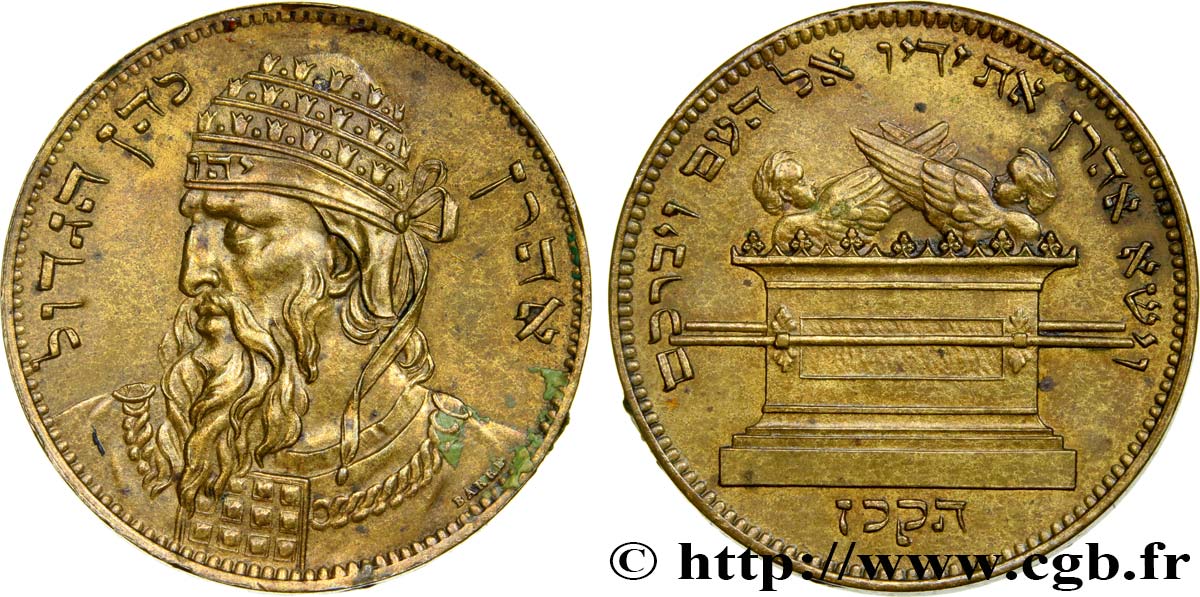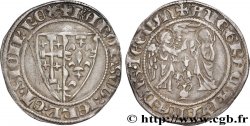fme_442238 - CHARLES X Médaille d’Aaron avec l’arche de l’Alliance
Not available.
Item sold on our e-shop (2019)
Price : 120.00 €
Item sold on our e-shop (2019)
Price : 120.00 €
Type : Médaille d’Aaron avec l’arche de l’Alliance
Date: 1827
Mint name / Town : 75 - Paris
Metal : bronze
Diameter : 34 mm
Orientation dies : 12 h.
Engraver BARRE
Weight : 18,2 g.
Edge : lisse
Coments on the condition:
Médaille intéressante avec une agréable patine dorée
Obverse
Obverse legend : LÉGENDE HÉBRAÏQUE.
Obverse description : Buste du grand prêtre Aaron de trois quarts à gauche.
Reverse
Reverse legend : LÉGENDE HÉBRAÏQUE.
Reverse description : Arche de l’Alliance, avec les deux chérubins sur le couvercle.
Commentary
Médaille énigmatique, avec des légendes hébraïque, datée 1827 sur la tranche. D’après les exemplaires conservés au musée d’Art et d'Histoire du Judaïsme (MAHJ), il existerait trois types de droit différents ; un pour Aaron (avec l’Arche de l’Alliance au revers), un pour Moïse (avec les tables de la Loi au revers) et un pour David (avec une Lyre au revers).
Aaron est le premier grand prêtre d’Israël.
L’Arche d'Alliance est le coffre qui, selon la Bible, contient les tables de la Loi (Dix Commandements) données à Moïse sur le mont Sinaï.
C'est un coffre oblong de bois recouvert d'or. Le propitiatoire surmonté de deux chérubins, qui en forme le couvercle, est considéré comme le trône, la résidence terrestre de YHWH (Jéhovah) (Exode 25:22). Lorsque le tabernacle fut terminé, l’arche fut mise dans le saint des saints, la partie la plus centrale du Temple de Salomon. (1 Rois 8:1-8)..
Enigmatic medal, with Hebrew legends, dated 1827 on the edge. According to the examples preserved at the Museum of Jewish Art and History (MAHJ), there are three different types of rights: one for Aaron (with the Ark of the Covenant on the reverse), one for Moses (with the tablets of the Law on the reverse), and one for David (with a lyre on the reverse). Aaron is the first high priest of Israel. The Ark of the Covenant is the chest that, according to the Bible, contains the tablets of the Law (Ten Commandments) given to Moses on Mount Sinai. It is an oblong wooden chest covered in gold. The mercy seat surmounted by two cherubim, which forms its lid, is considered the throne, the earthly residence of YHWH (Jehovah) (Exodus 25:22). When the tabernacle was completed, the ark was placed in the Holy of Holies, the most central part of Solomon's Temple. (1 Kings 8:1-8).
Aaron est le premier grand prêtre d’Israël.
L’Arche d'Alliance est le coffre qui, selon la Bible, contient les tables de la Loi (Dix Commandements) données à Moïse sur le mont Sinaï.
C'est un coffre oblong de bois recouvert d'or. Le propitiatoire surmonté de deux chérubins, qui en forme le couvercle, est considéré comme le trône, la résidence terrestre de YHWH (Jéhovah) (Exode 25:22). Lorsque le tabernacle fut terminé, l’arche fut mise dans le saint des saints, la partie la plus centrale du Temple de Salomon. (1 Rois 8:1-8)..
Enigmatic medal, with Hebrew legends, dated 1827 on the edge. According to the examples preserved at the Museum of Jewish Art and History (MAHJ), there are three different types of rights: one for Aaron (with the Ark of the Covenant on the reverse), one for Moses (with the tablets of the Law on the reverse), and one for David (with a lyre on the reverse). Aaron is the first high priest of Israel. The Ark of the Covenant is the chest that, according to the Bible, contains the tablets of the Law (Ten Commandments) given to Moses on Mount Sinai. It is an oblong wooden chest covered in gold. The mercy seat surmounted by two cherubim, which forms its lid, is considered the throne, the earthly residence of YHWH (Jehovah) (Exodus 25:22). When the tabernacle was completed, the ark was placed in the Holy of Holies, the most central part of Solomon's Temple. (1 Kings 8:1-8).








 Report a mistake
Report a mistake Print the page
Print the page Share my selection
Share my selection Ask a question
Ask a question Consign / sell
Consign / sell
 Full data
Full data











